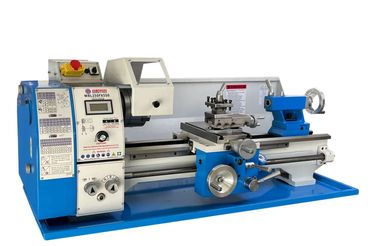Lathe Machine Maintenance: Essential Tips for Longevity and Performance
When it comes to metalworking or woodworking, a lathe machine is a crucial tool that shapes, cuts, and finishes materials with precision. However, like any other machine, it requires regular care to maintain its performance and longevity. In this blog post, we will explore essential lathe machine maintenance tips, ensuring your equipment stays in top condition for years to come.
1. Regular Cleaning and Lubrication
One of the simplest yet most effective ways to extend the life of your lathe machine is regular cleaning and lubrication. Dust, debris, and metal shavings can accumulate on the machine’s surface and internal parts, leading to wear and tear over time. Clean the lathe after every use, removing all metal shavings and dust with a soft brush or compressed air. Make sure to clean the chuck, bedways, and tool post thoroughly.
Lubrication is equally important. Apply the recommended lubricating oil to the lathe’s moving parts, such as the spindle, gears, and bearings. Regular lubrication reduces friction, preventing excessive wear and overheating. Check the manufacturer’s guidelines for the correct type of oil and lubrication intervals.
2. Inspect and Tighten Fasteners Regularly
A lathe machine is subjected to constant vibrations and movement during operation, which can cause nuts, bolts, and screws to loosen over time. Perform a routine check of all fasteners, especially those securing the headstock, tailstock, tool rest, and bed. Tighten any loose fasteners to avoid any misalignment or mechanical issues that could affect the machine's accuracy and performance.
3. Check the Alignment and Calibration
For a lathe machine to function correctly, its components must be properly aligned. Misalignment can result in uneven cuts, increased wear, and reduced precision. Regularly check the alignment of the headstock, tailstock, and tool rest using an alignment gauge. Adjust these components as needed to ensure they are parallel and aligned correctly.
Calibration is also key. Over time, the machine’s measurements may drift, affecting the quality of the work. Use dial indicators or micrometers to check the accuracy of the lathe’s settings and make any necessary adjustments. Accurate calibration ensures consistent performance and extends the machine's lifespan.
4. Monitor Electrical Components and Wiring
Lathe machines, especially CNC lathes, rely on electrical components for operation. Check the electrical wiring, switches, and control panels regularly for any signs of wear, corrosion, or damage. Replace worn or damaged wires immediately to avoid electrical failures or safety hazards.
For CNC lathe machines, it's also essential to update software and firmware as needed. Regular software updates ensure that your machine operates at peak efficiency and benefits from the latest features and bug fixes.
5. Replace Worn Parts Promptly
Over time, certain parts of your lathe machine, such as belts, gears, and bearings, may wear out due to constant use. Inspect these parts regularly for any signs of damage or wear. Replace worn parts promptly to prevent further damage to the machine and maintain its performance. Using high-quality replacement parts can also improve the longevity and efficiency of the lathe machine.
6. Keep the Machine in a Controlled Environment
Environmental factors like temperature, humidity, and dust can significantly affect the performance of a lathe machine. Store the machine in a dry, clean, and temperature-controlled environment to prevent rust, corrosion, and other damages caused by fluctuating conditions. If your workshop is prone to dust, consider using covers or protective enclosures for the machine when not in use.
7. Follow a Preventive Maintenance Schedule
Adopting a preventive maintenance schedule is crucial for the long-term health of your lathe machine. Create a checklist that includes all the necessary maintenance tasks, such as cleaning, lubrication, alignment checks, and part replacements. Stick to this schedule diligently, whether it’s daily, weekly, or monthly, based on the machine’s usage and the manufacturer's recommendations.
8. Train Operators and Follow Safety Guidelines
Proper handling of the lathe machine is essential for both performance and safety. Ensure that all operators are well-trained in the machine's operation and maintenance procedures. Follow the manufacturer’s safety guidelines, such as wearing protective gear, using guards, and maintaining a safe distance from moving parts.
By educating your team on best practices, you reduce the likelihood of accidents and machine damage, thus prolonging its lifespan.
9. Conduct Regular Professional Inspections
While regular in-house maintenance is vital, it’s also wise to have the machine inspected by a professional periodically. Certified technicians can identify potential issues that might not be apparent during routine checks. These experts can provide valuable advice on maintenance best practices and offer services like precision alignment and calibration that are beyond the scope of regular operators.
10. Keep a Record of Maintenance Activities
Maintaining a logbook of all maintenance activities is a good practice. Record details such as the date of maintenance, tasks performed, parts replaced, and any observations made. This record helps track the machine’s health, identify recurring issues, and plan future maintenance activities more effectively.
Conclusion
Lathe machines are indispensable tools in various industries, and proper maintenance is key to their long-term performance and reliability. By following these essential maintenance tips, you can ensure your lathe machine remains efficient, safe, and operational for many years. Remember, regular cleaning, lubrication, and inspections, along with prompt replacement of worn parts and adherence to a preventive maintenance schedule, will help keep your machine in prime condition, reducing downtime and repair costs.
Related blog: How do I choose a lathe machine?



